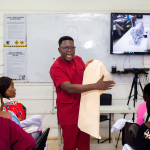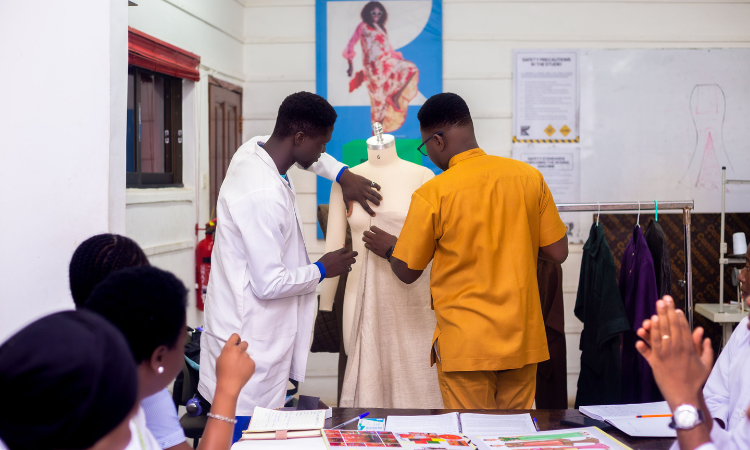
Transforming Fashion Education and Practice with Richard Ohene Sika
June 9, 2024
Building a Personal Brand in the Fashion Industry
June 9, 2024Sustainability has become a critical issue in the fashion industry, with increasing awareness of its environmental and ethical impacts. Richard Ohene Sika, a distinguished Fashion Educator and Consultant, explores how fashion education can instill sustainable practices in the next generation of designers.
Understanding Sustainability in Fashion
Sustainability in fashion encompasses various aspects, including the use of eco-friendly materials, ethical production practices, and reducing waste. Richard emphasizes that students must understand the entire lifecycle of a garment, from raw material sourcing to end-of-life disposal.
Eco-Friendly Materials
Sustainable fashion starts with the materials used. Educating students about eco-friendly materials such as organic cotton, bamboo, hemp, and recycled fabrics is crucial. These materials often have a lower environmental impact compared to conventional textiles, which can be resource-intensive and polluting.
Ethical Production Practices
Beyond materials, ethical production practices are vital. This includes fair labor practices, ensuring safe working conditions, and minimizing the environmental footprint of manufacturing processes. Richard stresses that students need to be aware of the social and environmental implications of production choices and should strive to support fair trade and other ethical initiatives.
Lifecycle of a Garment
Understanding the entire lifecycle of a garment helps students make more sustainable design decisions. This involves considering the sourcing of raw materials, the energy and water used in production, the potential for recycling or upcycling at the end of the garment’s life, and ways to reduce waste throughout the process.
Incorporating Sustainability into the Curriculum
Richard suggests integrating sustainability into every aspect of fashion education. This holistic approach ensures that students not only learn about sustainable practices but also internalize them as a core aspect of their design philosophy.
Sustainable Materials and Techniques
Courses should cover sustainable materials and innovative techniques that minimize waste. For instance, students can learn about zero-waste pattern making, which maximizes the use of fabric, or upcycling, where old garments are transformed into new pieces.
Ethical Production Methods
Educators should emphasize ethical production methods, teaching students about the impact of their choices on both people and the planet. This includes understanding the benefits of local production, supporting fair trade, and implementing practices that reduce carbon footprints.
Innovative Thinking
Encouraging innovative thinking around sustainability is essential. Projects that challenge students to create zero-waste designs or repurpose existing garments foster a practical understanding of sustainable practices. Richard believes that innovation and creativity are key to developing new solutions that address environmental and social challenges in the fashion industry.
Industry Collaboration and Real-World Experience
Collaboration with industry partners is crucial for providing students with real-world insights into sustainable practices. Richard highlights the importance of internships and projects with sustainable fashion brands, giving students hands-on experience in implementing eco-friendly practices.
Internships and Industry Projects
Internships with sustainable fashion brands allow students to see firsthand how sustainability can be integrated into various aspects of fashion design and production. These experiences provide valuable insights into the challenges and opportunities of sustainable fashion and help bridge the gap between theoretical knowledge and practical application.
Guest Lectures and Workshops
Inviting industry experts to give guest lectures or lead workshops can enrich the curriculum. These sessions can cover topics such as sustainable business models, the latest sustainable materials, and innovative technologies. Hearing directly from professionals who are at the forefront of sustainable fashion can inspire and motivate students.
Collaborative Projects
Collaborative projects with industry partners can also be highly beneficial. These projects allow students to work on real-world challenges, develop practical solutions, and see the impact of their work. Such collaborations can lead to valuable networking opportunities and potential job placements after graduation.
Conclusion
By fostering a strong foundation in sustainability, educators can empower the next generation of designers to lead the industry towards a more ethical and environmentally friendly future. Richard Ohene Sika’s insights highlight the importance of integrating sustainability into fashion education. Through understanding the full lifecycle of garments, incorporating sustainable materials and techniques, and gaining real-world experience, students can become champions of sustainable fashion. This comprehensive approach not only equips them with the necessary skills and knowledge but also instills a sense of responsibility towards the environment and society. As the fashion industry continues to evolve, these future designers will be well-prepared to make a positive impact and drive the industry towards greater sustainability.

